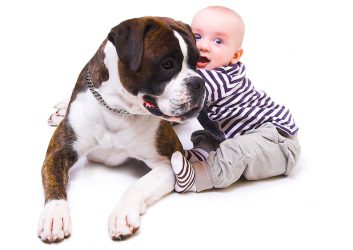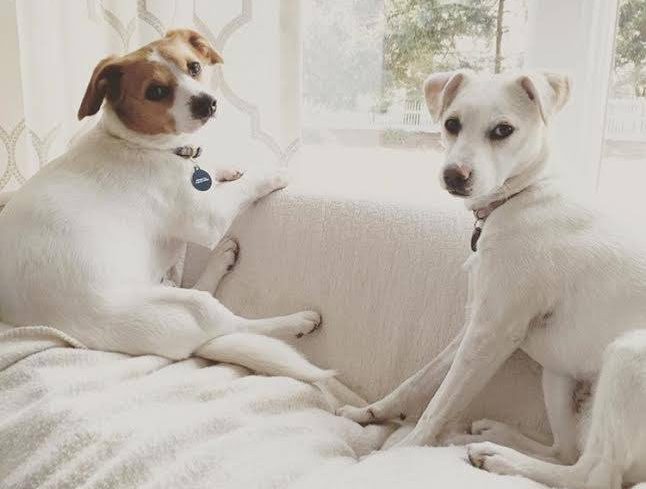Babies & Dogs 101
 Dogs and kids have been immortalized in movies and on television for decades. Whether you remember the Petey from The Little Rascals, Lassie and Timmy, Benji, Beethoven, or Clifford the Big Red Dog, the images of kids hugging and kissing dogs are burned in our minds. For dog trainers, those scenes make us cringe because we see the sometimes-tragic results of the non-movie-non-scripted interactions.
Dogs and kids have been immortalized in movies and on television for decades. Whether you remember the Petey from The Little Rascals, Lassie and Timmy, Benji, Beethoven, or Clifford the Big Red Dog, the images of kids hugging and kissing dogs are burned in our minds. For dog trainers, those scenes make us cringe because we see the sometimes-tragic results of the non-movie-non-scripted interactions.
A new student of mine came in because her 5-year-old spaniel bit her grandson in the face. The dog was sleeping next to her chair and when the child ran up behind him and grabbed his neck to give him a hug, the dog bit him in the face. Eighty six stitches later, the family called me. The next day, their vet found that the dog had a punctured eardrum, a raging double ear infection and a cracked rib. This was a dog in tremendous pain, but no one was aware of it. Had they understood dog body language, noticed a difference in his behavior over weeks preceding Thanksgiving (they did) and taken him to the vet (they didn’t) and had taught their children proper dog-kid interaction and supervised any and all movement of the child, their Thanksgiving wouldn’t have been cut short with a visit to the ER.
Here’s some ideas for helping the children and dogs in your life have a happy, safe and harmonious relationship.
Babies and Dogs 101
When the baby arrives home, most parents are eager to introduce their new arrival to the dog, but the truth is that this is not the high risk period. After the first 8 weeks, we get into a much more difficult stage. In my opinion, Jen Shyrock of Family Paws Education is, in my opinion, the best source of information on his topic. Her wonderful programs “Dogs and Storks” and “Dogs and Babies Connection” (of which I’m a licensed presenter) help educate parents and parents to be.
“Pat The Bunny” (but not the doggie). Parents tend to teach their babies to “pat the doggie”, believing that if the intention behind the action was loving, then it would be interpreted that way by the dog. That’s not true, especially if the dog is unsure or wary of the child. In addition, it children can become magnetized to dogs and once they’re toddlers they see dogs as friendly creatures who you should run up to and hug. That can scare small and large dogs alike, and then things can go terribly wrong. When my children were little, I taught them to admire dogs from a distance.
Tips for those of you with children 2 yrs of age and older:
1. Do As I Do
Telling your kids to keep their face away from the dog when they see you kissing the dog on the mouth and holding it against your face like a baby is a guaranteed way to undermine your words. Kids mirror what the adults in their lives do, so if you must “kitchey koo” your dog, do it when the kids are in bed.
2. “How Would You Like It If…?”
Teach your kids to understand in a way that they can relate to: “ If You don’t like it – a dog probably doesn’t either!” That means don’t take their toys/stuff, don’t stick your hands in their bowl, keep your face away from theirs, don’t squeeze them, lay on them or try to ride them , don’t wake them up while they’re sleeping, and don’t scream and yell around them. And lest you think this is a one time talk, think again. As the kids grow and change, you need to keep reiterating the rules, interpreting the dog’s body language for them, and giving them feedback (positive and negative) on their behavior towards the dog.
3. Learn to Recognize The Signs. If you can’t recognize when your dog is stressed, then you can’t teach your children to recognize it either. Find a reputable trainer in your area who teaches interpretation of a dog’s body language so you know what your dog is trying to tell you. A dog’s breathing changes, closed mouth, lip licking, and turning it’s head away from you all mean something. Supervision means not only watching your child and dog, it also means understanding what you’re looking at and intervening if necessary.
At this point, you’re probably thinking “ Hey! I got this dog for my kids. What CAN they do with the dog?”
Here’s a list of interactions that can be mutually fun for both child and dog. Please note that all children and dogs should only have SUPERVISED interactions. You need to be watching to make sure that the child and the dog are enjoying the interaction. The minute that one isn’t, you need to intervene.
1. Fetch! As long as you’re there to make sure that the dog doesn’t knock the child down to get the toy and that the child doesn’t wrestle the toy from the dog’s mouth, fetch is a fun game for both kids and dogs.
2. Go For A Walk. You can hold one leash and your child can hold a second attached to the dog’s collar. That way, you have the control and your child has the experience of walking his dog.
3. Tricks. Teach your dog a few tricks (with or without your child’s help). A dog that shakes, rolls over and “speaks” can earn food rewards by doing a behavior that the child will love to ask for.
4. Your Child: The Human Pez Dispenser. If your dog sees your child as a source of rewards (food), he’s more inclined to engage him or her with behaviors that you’ve taught your dog (for example: sitting politely) can earn him food.
5. Hide Out/Rescue Me. My kids loved to play this game when they were little. They’d hide (and have a really fabulous food reward with them) and I would send the dog to “Find Them!” When our dog found them, they’d stand up, ask him to sit and reward him the treat. Their giggling may have helped the dog find them, but no matter. A good, safe and fun interaction was had by all.
 Kathy Santo and Stacey Samela are NJ’s only licensed presenters for the nationally acclaimed Dog&Stork program. For more information, please visit our website at kathysantodogtraining.com or email Stacey at mail4stacey@aol.com
Kathy Santo and Stacey Samela are NJ’s only licensed presenters for the nationally acclaimed Dog&Stork program. For more information, please visit our website at kathysantodogtraining.com or email Stacey at mail4stacey@aol.com
Should You Let Your Pets Sleep with You?
My Dog Has Accidents in the SAME SPOT! Why?





















